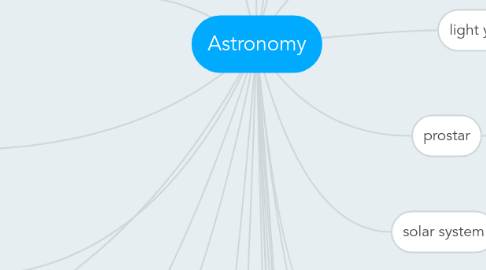
1. the sun
1.1. The sun first began shining about 5 billion years ago and is expected to continue shining for about 5 billion years more
1.2. The two layers we can only see during a solar eclipse is the chromosphere And corona
1.3. The layer that is considered to be the boundary of the sun is the photosphere
1.3.1. Which we see from earth
1.4. Nuclear fusion occurs in the core of the sun
1.4.1. This is the process in which light atoms fuse and become very hot and very bright
1.5. Two elements that make up 99% of the sun.
1.5.1. hydrogen and helium
1.6. Solar flare: Is a massive explosion at the surface of the sun
1.6.1. Coronal mass ejection: when this occurs a large amount of plasma is thrown out through the corona
1.6.2. The earth is protected by solar flares and coronal ejection reaching our planet is by earths magnetic field diverting much of the plasma away from the planet
2. dark matter
2.1. Refers to matter in the universe that is invisible
2.2. 27% of the universe is filled with dark matter
3. 3 characteristics stars are arranged by
3.1. Surface temperature: The hottest stars are plotted on the left, and the coolest stars are plotted on the right.
3.2. Colour- Red stars are plotted on the right, and blue plotted on the left. Other stars, such as the yellow sun are plotted in between
3.3. Luminosity: The brightest stars are plotted at the top and dimmest stars are plotted at the bottom
3.4. Groups of stars that DO NOT appear in the sequence often at the end of their lives
3.4.1. White dwarfs: Are white because they are hot but dim because they are small. White dwarfs are cooling eventually become black
3.4.1.1. Red Giants: The outer layer of these stars are cool and appear red, but they are bright because they are so large. All of these giants will eventually explode
4. geostationary orbit
4.1. A satellite that orbits earth at the same rate as the earths rotates, making it look stationary (in one place)
5. 3 different shapes galaxies can have
5.1. Elliptical: Is a shape like a flatted sphere. Elliptical galaxies are those whose shape ranges. This happens when galaxies merge
5.2. Spiral and Barred spiral galaxy: spiral is named for its spiral arms and if it also has what looks like bars across them, they are called a barred spiral galaxy.
5.2.1. the Milky Way is a spiral galaxy
5.3. Irregular: If a galaxy isn't like a spiral or Elliptical or without a shape, it is a irregular Galaxy
6. satellite
6.1. A device placed in orbit around earth or another celestial object
6.2. Artificial satellite is an artificial body placed in orbit to collect information or for communication
7. All galaxies have stars, planets and dust
8. Hertzsprung-Russel diagram: created by Ejnar Hertzsprung and Henry Norris Russel
8.1. they wanted to find out whether any pattern might emerge that would tell us more about the nature of stars, there was and this diagram was made
9. gps
9.1. stands for global positioning system and uses at least 3 satellites to pin point your location using low energy microwave signals.
10. spinoff
10.1. A secondary beneficial effect or product of a thing or activity in this case from the technology they use in space like a smoke dectector
11. Planets
11.1. four inner planets (rocky planets)
11.1.1. Mercury, Venus, Earth, Mars
11.2. four outer planets (gas and ice)
11.2.1. Jupiter,Saturn,Uranus, Neptune
11.3. the asteroid belt divides the rocky and gaseous planets
11.4. one minor or dwarf planets
11.4.1. Pluto
12. asteroid belt
12.1. A region of rocky debris that forms a ring all the way around the sun and the inner planets at a distance of about 3 AU. The asteroid contains billions of pieces of rock of all sizes
13. supernova
13.1. is when a star explodes, the gradual build up of heavy elements in the stars center cause the core to collapse
14. light year
14.1. (LY) It equals the distance that a beam of light can travel through space in one year. It is equivalent to 63 billion Km
15. nebula
15.1. is a large cloud of dust and gas. Nebula are often called star nurseries, because it is form their dust and develop in
16. astronomical unit
16.1. (AU) equals the average distance between the sun and the earth in millions of km
17. black hole
17.1. A region of space where Gravity is so strong the nothing, not even light can escape.
17.2. The gravity also pulls in stars destroying them, and adds mass to the black hole increasing its size
17.3. Also centre of all galaxies
18. nuclear fusion
18.1. process in which the nuclei of atoms fuse together and form larger atoms
19. microgravity
19.1. Affects can be reduced by exercising
19.2. Condition in which the gravitational forces that act on mass are greatly reduced
19.2.1. heart weakens
19.2.2. immune system weakens
19.2.3. muscle mass goes down
20. 3 general mass categories used to describe stars
20.1. Low mass: Use their nuclear fuel much slower so they last longer
20.1.1. most stars in the universe are low mass
20.2. Medium mass: Burn their fuel faster than low mass. The sun is a medium mass dwarf star
20.3. High mass: Are 10 times the mass of the sun. As gravity pulls matter into the center of the star, the star is hotter, brighter, and bluer than other stars.
21. 4 main types of spacecrafts
21.1. rocket
21.2. Spacestation
21.2.1. the international space station (ISS) is the biggest space station ever built
